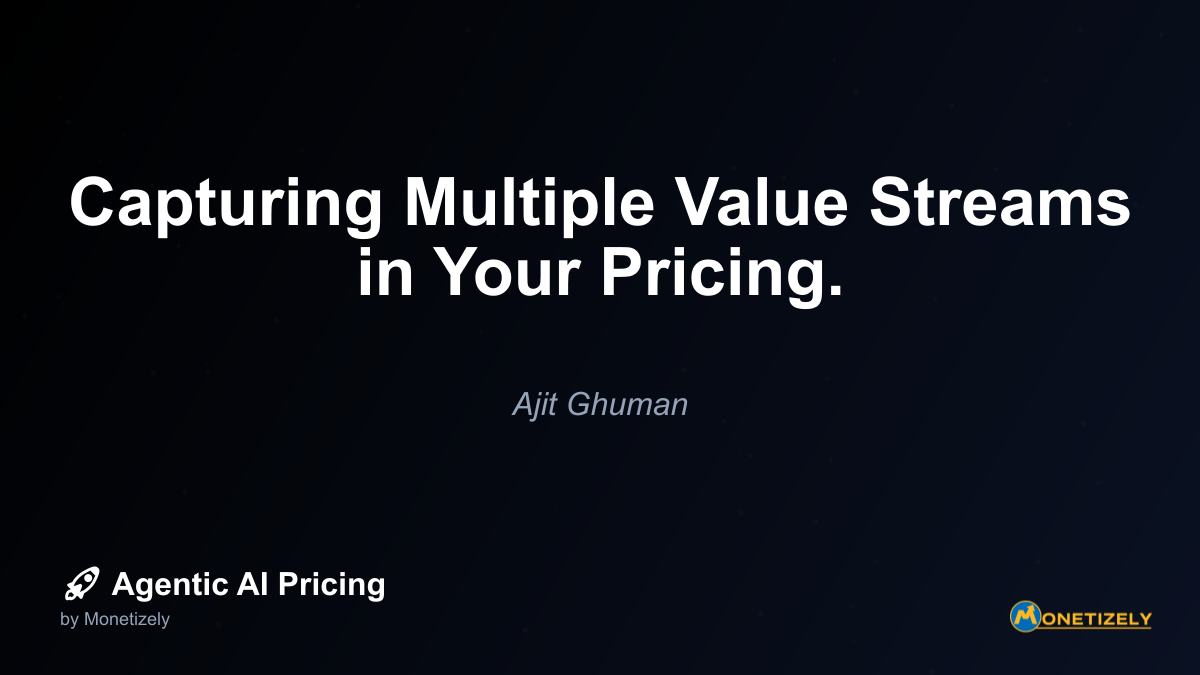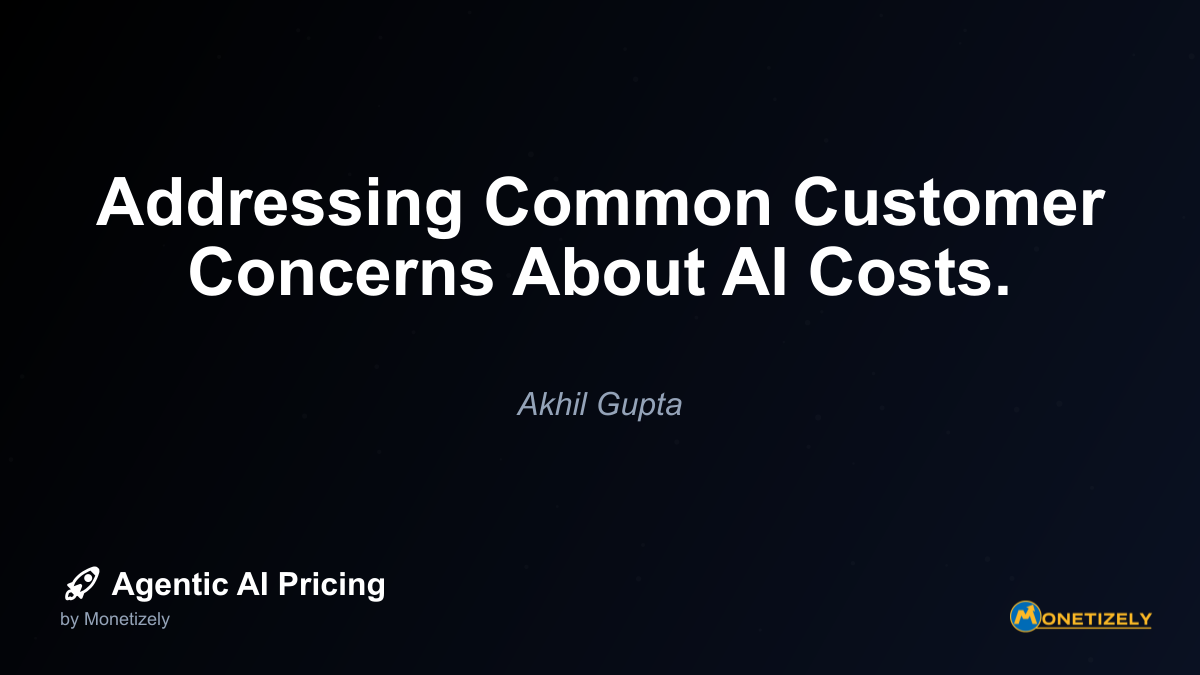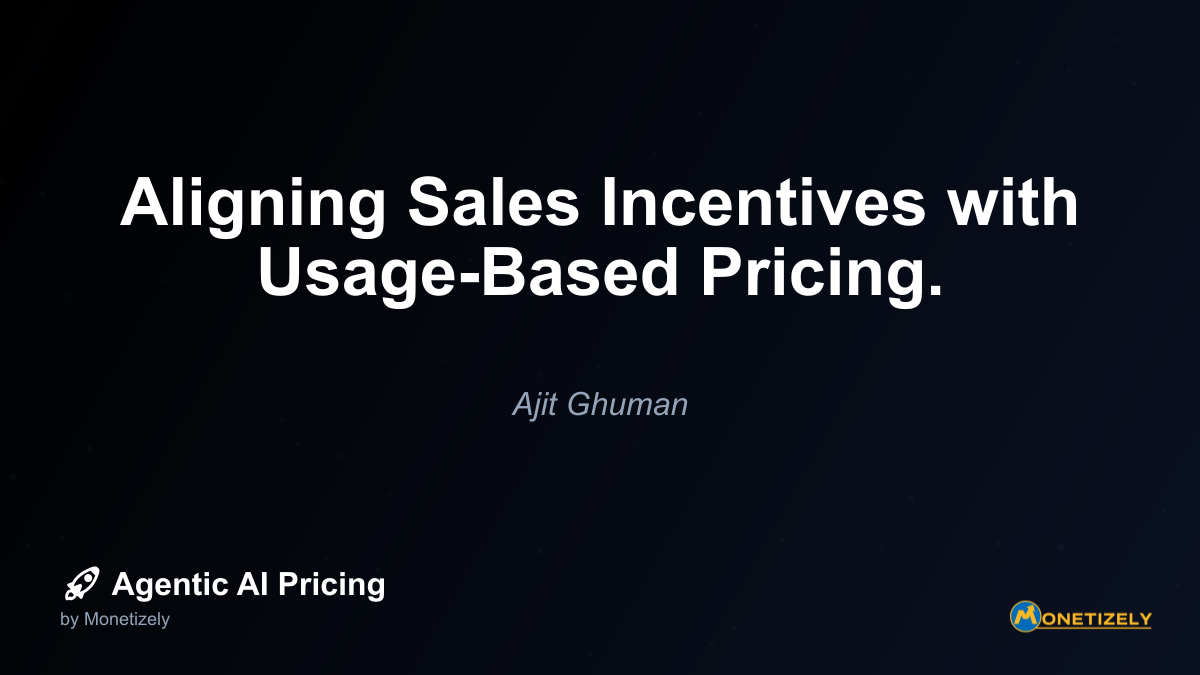· Ajit Ghuman · Best Practices · 7 min read
Capturing Multiple Value Streams in Your Pricing.
AI and SaaS Pricing Masterclass
Learn the art of strategic pricing directly from industry experts. Our comprehensive course provides frameworks and methodologies for optimizing your pricing strategy in the evolving AI landscape. Earn a professional certification that can be imported directly to your LinkedIn profile.

In today’s rapidly evolving AI landscape, agentic AI solutions offer unprecedented opportunities to deliver value across multiple dimensions simultaneously. However, this multi-faceted value creation presents unique challenges for pricing strategists. How do you effectively capture the full spectrum of value your agentic AI delivers without leaving money on the table or pricing yourself out of the market?
Understanding Multi-Dimensional Value in Agentic AI
Agentic AI solutions—those autonomous systems that can perceive, decide, and act on behalf of users—fundamentally differ from traditional software in their value delivery mechanisms. While conventional SaaS might excel at a single function, agentic AI often creates value across multiple streams simultaneously:
- Labor efficiency - Automating tasks that previously required human intervention
- Quality improvements - Reducing errors and enhancing output consistency
- Revenue generation - Creating new business opportunities and income streams
- Risk reduction - Mitigating potential losses through predictive capabilities
- Strategic insights - Surfacing patterns and opportunities invisible to human analysis
Each value stream represents a distinct benefit that could theoretically command its own pricing structure. The challenge lies in developing a coherent pricing strategy that captures this multi-dimensional value while remaining comprehensible to customers.
The Pitfalls of Single-Dimension Pricing
Many agentic AI providers fall into the trap of anchoring their pricing to just one value dimension, typically the most easily quantifiable one. This approach creates several problems:
Undervaluation
When you price solely based on time savings, you leave tremendous value uncaptured if your solution also improves quality and generates new revenue. Consider an agentic AI that helps sales teams by both qualifying leads (saving time) and identifying high-value prospects (increasing revenue). Pricing based only on time savings neglects the potentially larger revenue impact.
Misaligned Incentives
Single-dimension pricing can create misalignment between your interests and your customers’. If you price solely on usage metrics while your customer values outcomes, you may end up optimizing for increased usage rather than improved results.
Commoditization Risk
When you emphasize just one value dimension, you invite comparison with solutions that excel only in that dimension but may be vastly inferior in others. This positions your multi-faceted solution as a commodity, driving price pressure.
Mapping Your Value Streams
Before designing a multi-dimensional pricing strategy, you need a clear understanding of all the ways your agentic AI creates value. Follow these steps:
1. Conduct Value Discovery Interviews
Speak with current or potential customers to understand how they perceive value from your solution. Ask questions like:
- “What problems does our solution solve for you?”
- “How would you quantify the impact in financial terms?”
- “What alternative approaches would you consider if our solution wasn’t available?”
- “Which aspects of our solution would be most difficult to replace?“
2. Categorize Value Streams
Organize the identified value into distinct categories. Common value streams for agentic AI include:
- Efficiency value: Time and labor savings
- Quality value: Improved outcomes and reduced errors
- Strategic value: Better decisions and insights
- Revenue value: New or expanded income opportunities
- Risk value: Reduced likelihood or impact of negative events
3. Quantify Each Value Stream
For each value stream, develop methods to estimate the monetary impact. For example:
- Efficiency: (Hours saved × Hourly labor cost)
- Quality: (Error reduction × Cost per error)
- Revenue: (Incremental conversion rate × Average deal size)
4. Prioritize by Impact
Rank value streams by their financial impact and defensibility. Focus your pricing strategy on capturing value from the streams that matter most to customers and where your solution has a unique advantage.
Multi-Dimensional Pricing Structures
Once you understand your value streams, consider these pricing approaches designed to capture multi-faceted value:
Tiered Value-Based Pricing
Create packages that progressively unlock more value streams. For example:
- Basic Tier: Focuses on efficiency value (automation and time savings)
- Professional Tier: Adds quality value (improved outcomes, reduced errors)
- Enterprise Tier: Includes strategic value (insights, decision support)
This approach allows customers to self-select based on which value streams matter to them, while creating natural upsell paths as their needs evolve.
Outcome-Based Pricing Models
Link your pricing directly to the outcomes customers achieve across multiple dimensions:
- Base fee + percentage of documented cost savings
- Base fee + percentage of revenue generated
- Risk-sharing models where you get paid based on performance
These models align incentives perfectly but require sophisticated tracking and agreement on attribution methodologies.
Value-Metric Combinations
Instead of choosing a single value metric, use a combination that reflects different value streams:
- Core subscription based on users/usage (efficiency value)
- Surcharge based on volume processed (scale value)
- Success fee based on outcomes (quality/revenue value)
This approach allows you to capture value proportionally to how much the customer benefits across dimensions.
Dynamic Value Capture
For advanced agentic AI solutions, consider dynamic pricing that adjusts based on realized value:
- Initial pricing based on projected value
- Regular value assessments
- Price adjustments (up or down) based on documented results
This approach builds trust while ensuring fair value capture as the relationship evolves.
Communicating Multi-Dimensional Value
Even the best multi-dimensional pricing strategy fails if customers don’t understand the value they’re receiving. Here’s how to effectively communicate your value proposition:
Value-Based Messaging
Frame your marketing and sales communications around the full spectrum of value delivered, not just features or technical capabilities. For each customer segment, emphasize the value streams most relevant to their specific challenges.
ROI Calculators
Develop interactive tools that help prospects quantify the potential value of your solution across multiple dimensions. These calculators make abstract value concrete and build confidence in the investment decision.
Case Studies by Value Stream
Create case studies that highlight different value streams. Rather than generic success stories, develop targeted examples showing how specific customers benefited from particular aspects of your solution.
Value Realization Dashboards
Provide customers with ongoing visibility into the value they’re receiving across dimensions. These dashboards help justify continued investment and support expansion conversations.
Implementation Roadmap
Transitioning to multi-dimensional pricing requires careful planning. Follow this phased approach:
Phase 1: Value Discovery and Quantification
- Conduct customer interviews
- Map and quantify value streams
- Develop initial ROI calculator
Phase 2: Pricing Structure Design
- Design tiered offering based on value streams
- Develop value metrics for each dimension
- Create pricing communication materials
Phase 3: Pilot Testing
- Implement new pricing with select new customers
- Gather feedback and refine approach
- Document early success stories
Phase 4: Full Rollout
- Launch new pricing for all new customers
- Develop migration plan for existing customers
- Train sales team on communicating multi-dimensional value
Avoiding Common Pitfalls
As you implement multi-dimensional pricing, be aware of these potential challenges:
Complexity Overload
While your pricing should capture multiple value streams, it must remain comprehensible. If customers can’t easily understand what they’re paying for, they’ll resist your pricing regardless of the value delivered.
Solution: Limit visible pricing dimensions to 2-3, even if you’re capturing value from more streams behind the scenes.
Measurement Disputes
When pricing is tied to multiple outcomes, disagreements about measurement methodology can create friction.
Solution: Establish clear, objective measurement protocols upfront and include them in contracts.
Sales Team Resistance
Sales representatives may resist complex pricing models if they’re harder to explain or negotiate.
Solution: Develop clear talk tracks, objection handling guides, and compensation structures that reward selling on value rather than discounting.
Value Leakage
Some customers may extract value from dimensions you’re not capturing in your pricing.
Solution: Implement regular value reviews and contract structures that allow for adjustment as usage patterns evolve.
Case Study: Multi-Dimensional Pricing Success
Consider the example of an agentic AI solution for marketing content creation:
Initially, the company priced solely based on the number of content pieces generated, focusing on the efficiency value of faster content production. However, analysis revealed their solution delivered three distinct value streams:
- Production efficiency: 75% reduction in content creation time
- Quality improvement: 32% increase in engagement metrics
- Revenue impact: 28% increase in conversion rates from higher-quality content
By redesigning their pricing to include all three dimensions, they implemented:
- Base subscription tied to content volume (efficiency)
- Performance tier upgrades based on engagement metrics (quality)
- Success fee option for customers who could track conversions (revenue)
The results were dramatic:
- 47% increase in average contract value
- 23% improvement in retention rates
- 35% reduction in price objections during sales conversations
This multi-dimensional approach allowed them to capture a fair share of the total value created while giving customers flexibility to choose the model that best aligned with their priorities.
Conclusion
In the complex world of agentic AI, single-dimension pricing is increasingly inadequate. By mapping, quantifying, and effectively capturing value across multiple streams, you can develop pricing strategies that reflect the true impact of your solution while creating sustainable competitive advantage.
The most successful agentic AI companies don’t view pricing as simply setting a number—they see it as designing a value-capture system that evolves alongside their technology and customer relationships. By implementing the frameworks outlined in this article, you can ensure your pricing strategy matches the multi-dimensional value your agentic AI delivers.
As you refine your approach, remember that effective multi-dimensional pricing isn’t just about maximizing revenue—it’s about creating alignment between the value you create and the compensation you receive. When done right, this alignment drives sustainable growth by ensuring both you and your customers win together.
Co-Founder & CEO
Ajit is the author of Price To Scale, a top book on SaaS Pricing and is the Founder of Monetizely. Ajit has led and worked in pricing and product marketing at firms like Twilio, Narvar and Medallia. His work has been featured in Forbes and VentureBeat. Ajit regularly consults with software companies from Seed stage to post-IPO on pricing strategy. Ajit is also a highly-rated co-instructor for 'The Art of SaaS Pricing and Monetization' on Maven.
Pricing Strategy Audit
Let our experts analyze your current pricing strategy and identify opportunities for improvement. Our data-driven assessment will help you unlock untapped revenue potential and optimize your AI pricing approach.




